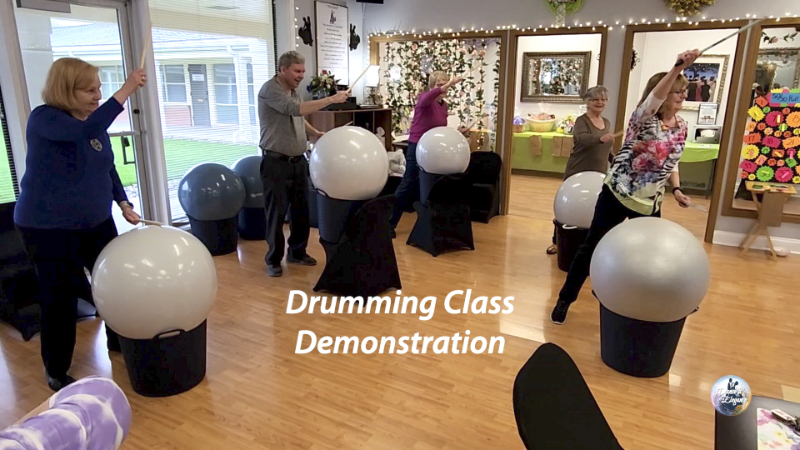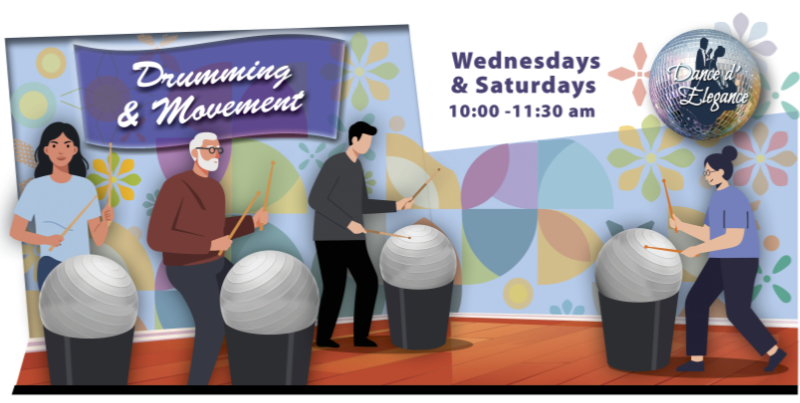Dance d’ Elegance
750 E. Washington St. #F1, Medina, OH 44256
Drumming, Dance and Parkinson's Improvement*
Connection between Drumming, Dance and Parkinson’s Improvement
Drumming and dance both harness the power of rhythm and music to help people with Parkinson’s overcome movement challenges, improve quality of life, and foster social and emotional well-being.
Their shared reliance on rhythmic entrainment and group participation makes them complementary, evidence-based approaches to non-pharmacological management of Parkinson’s symptoms.
How Drumming Helps Parkinson’s Patients
- Drumming requires the use of both sides of the brain and body, which is particularly beneficial for people with Parkinson’s, as the disease disrupts the connection between the brain and muscles. Engaging in drumming can help “reconnect those sides with our muscles and hands,” supporting improved coordination and function.
- Group drumming classes, such as drum circles, and cardio-drumming programs like Parkinson’s Beats, have been shown to improve quality of life, fitness, movement, and mood.
- Drumming leverages rhythmic entrainment—the brain’s natural synchronization to a beat—which provides external cues that help regulate and initiate movement. This is especially important for people with Parkinson’s, who often struggle with gait and movement initiation.
- Participants in drumming programs report reduced tremors, improved balance, enhanced mood, and greater social connection.
Dance and Parkinson’s
- Dance programs utilize music and rhythm to cue movement, thereby enhancing gait, balance, and overall movement quality.
- Dance, like drumming, relies on rhythmic cues and often incorporates whole-body movement, which can address both motor and non-motor symptoms of Parkinson’s.
- Argentine tango, which has roots in African drumming rhythms, has been specifically noted for its positive impact on motor outcomes in PD.
Shared Mechanisms: Rhythm and Entrainment
- Both drumming and dance utilize rhythmic entrainment, where the brain and body synchronize to external beats. This mechanism helps people with Parkinson’s bypass some of the movement initiation challenges caused by basal ganglia dysfunction.
- The rhythmic cues from music support the brain in planning and executing movements, leading to improvements in stride length, balance, and walking.
Physical, Cognitive, and Emotional Benefits
- Physical: Improved balance, strength, flexibility, and coordination due to the combination of rhythmic movement and exercise.
- Cognitive: Enhanced dual-tasking ability, as drumming and dance, require simultaneous motor and cognitive engagement5.
- Emotional/Social: Increased enjoyment, sense of achievement, reduced depression and anxiety, and improved social well-being from group participation and the experience of “flow.”
Connection Between Drumming, Dance, and Parkinson’s
Overview
Drumming and dance, both rooted in rhythmic movement and music, have shown significant benefits for people living with Parkinson’s disease (PD). These activities engage the brain and body in ways that can help address both motor and non-motor symptoms of the disease.

*References:
This is a summary the information from the following sources. For more on Drumming, Dance and Parkinson’s check out these articles.
An Exploration of People Living with Parkinson’s Experience of Cardio-Drumming; Parkinson’s Beats
Reconnecting Parkinson’s patients through drumming
Drum with DOPABEATS to Live Well with Parkinson’s
Exercise drumming for Parkinson’s: The beat goes on
DRUM‐PD: The Use of a Drum Circle to Improve the Symptoms and Signs of Parkinson’s Disease
The Helping Harmony of Music and Parkinson’s

